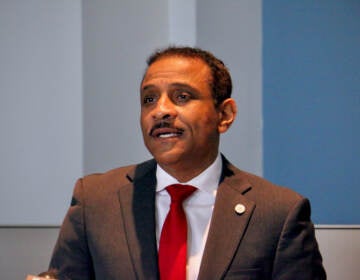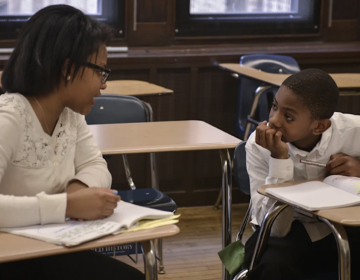How the other half learns: a field trip from Kensington to the suburbs
Listen 6:12-
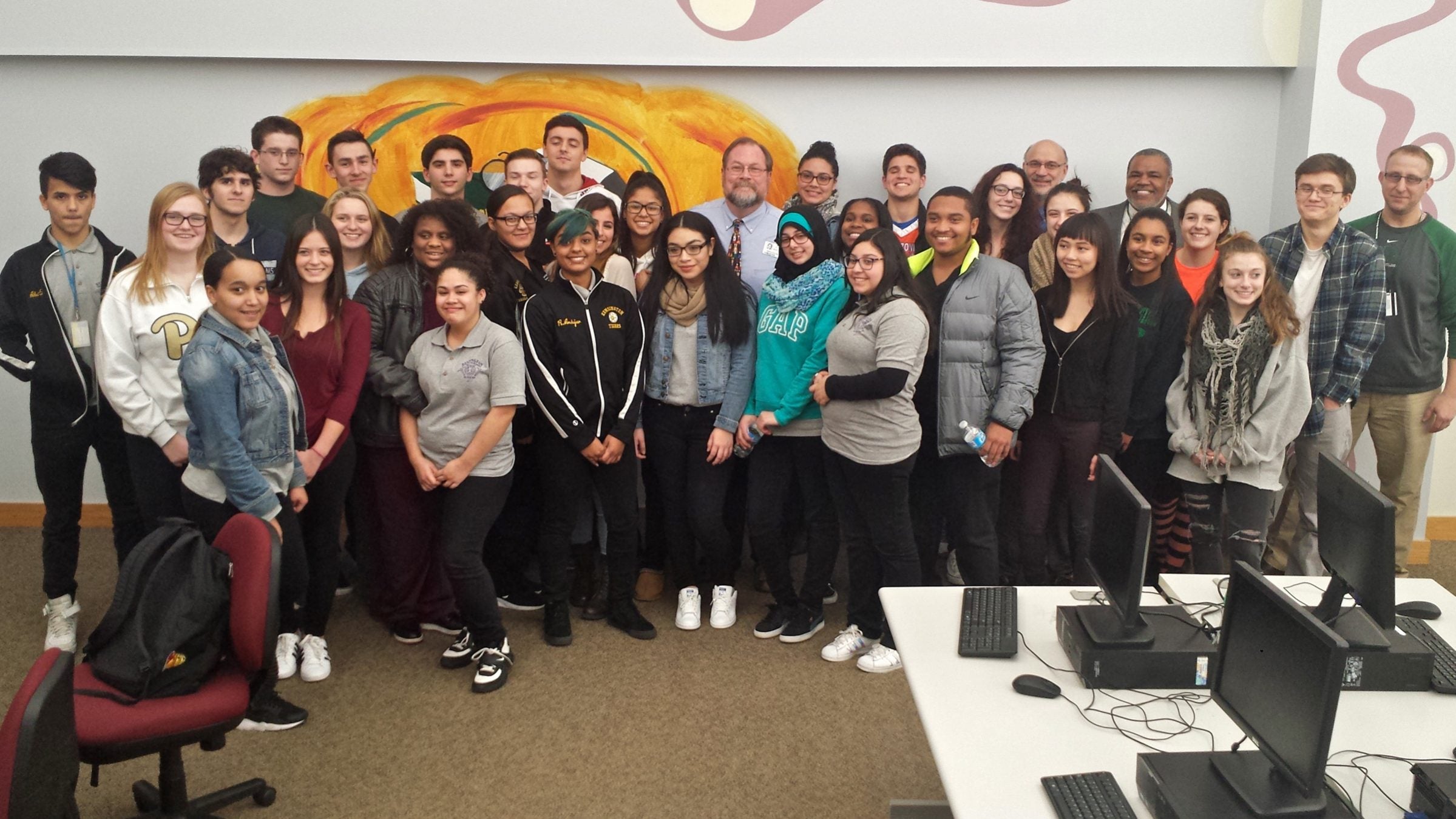
Kensington and Methacton students pose for a photo during an exchange visit to Methacton High School. (Kevin McCorry/WHYY)
-
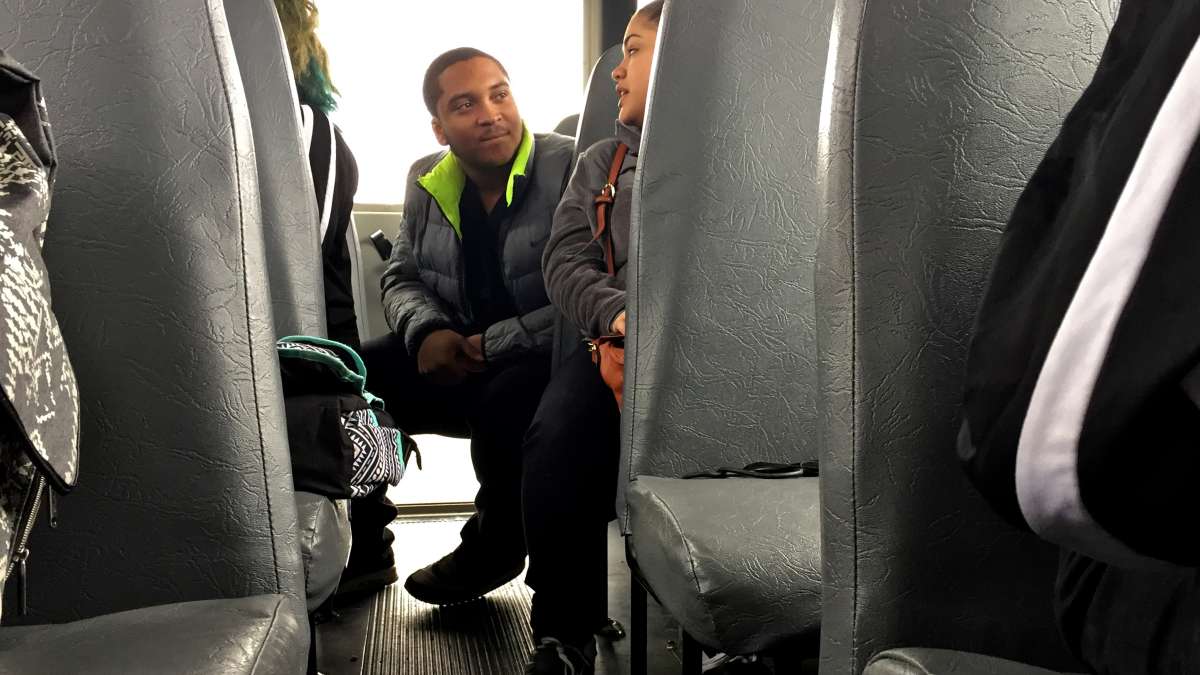
Hakeem Thompson, a Kensington Health Sciences Academy senior, chats with other students during a bus ride to Methacton. (Avi Wolfman-Arent/WHYY)
-
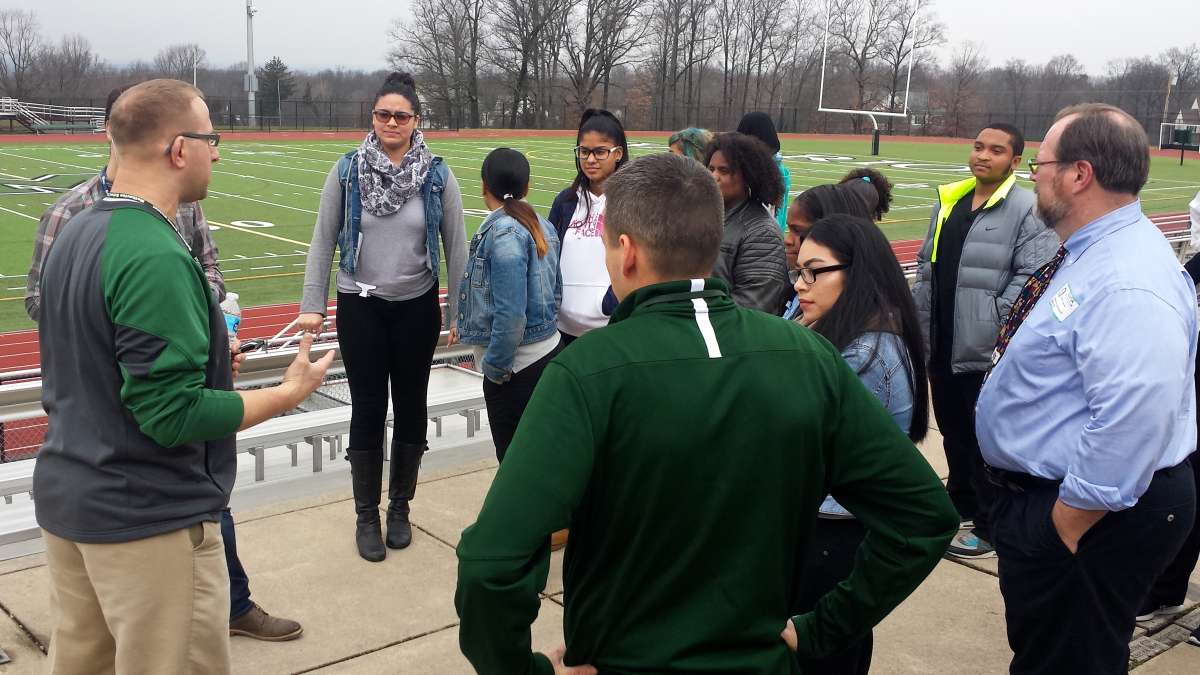
A. J. Maida leads students from Kensington Health Sciences Academy on a tour of the Methacton High School athletic facilities. (Kevin McCorry/WHYY)
-
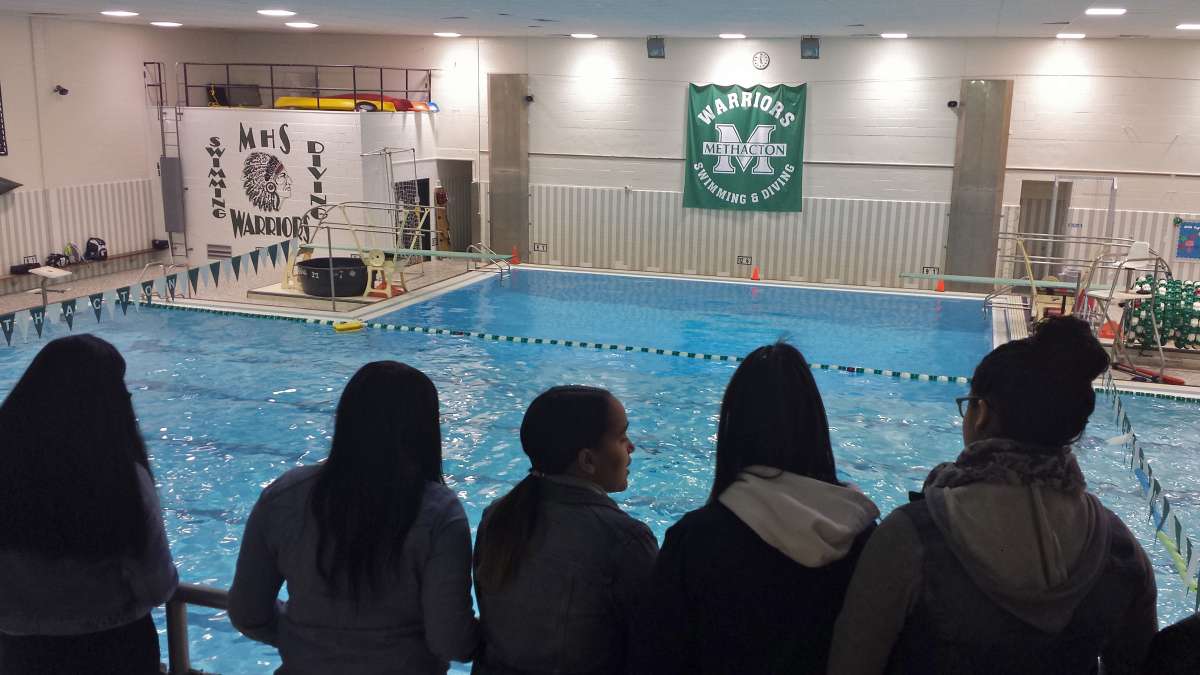
High school exchange: Kensington Health Sciences high school students tour the athletic facilities at Methacton High School. (Kevin McCorry/ WHYY)
-
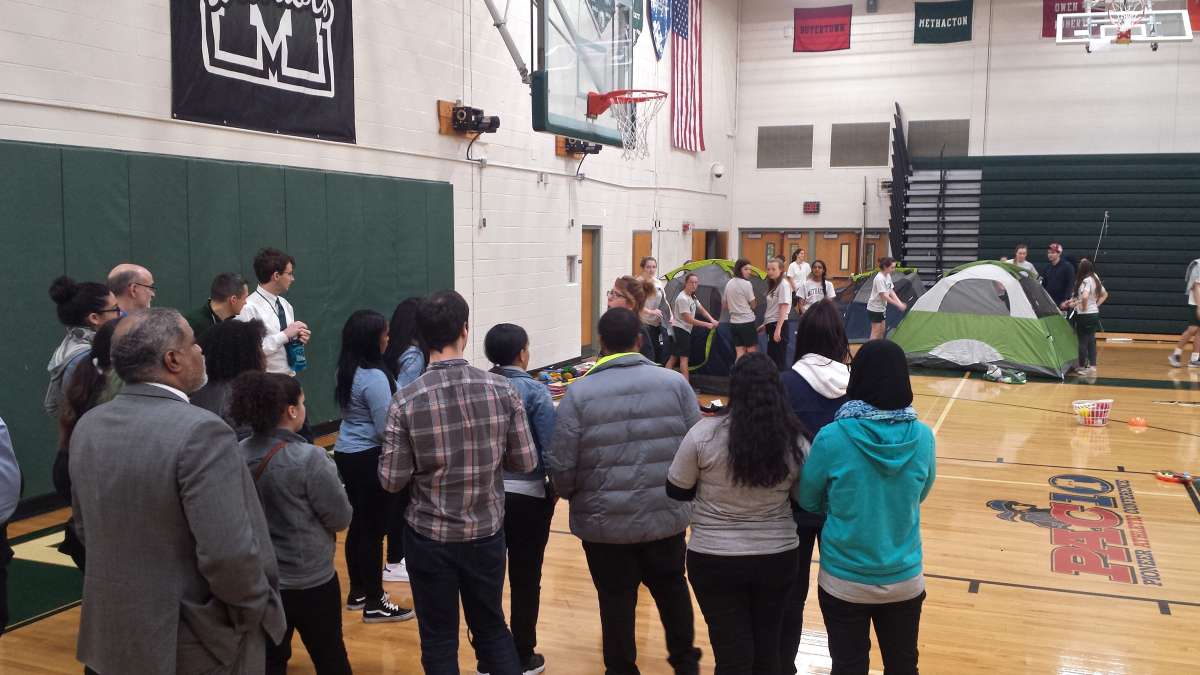
Kensington students drop in on a Methacton High School gym class. (Kevin McCorry/WHYY)
-
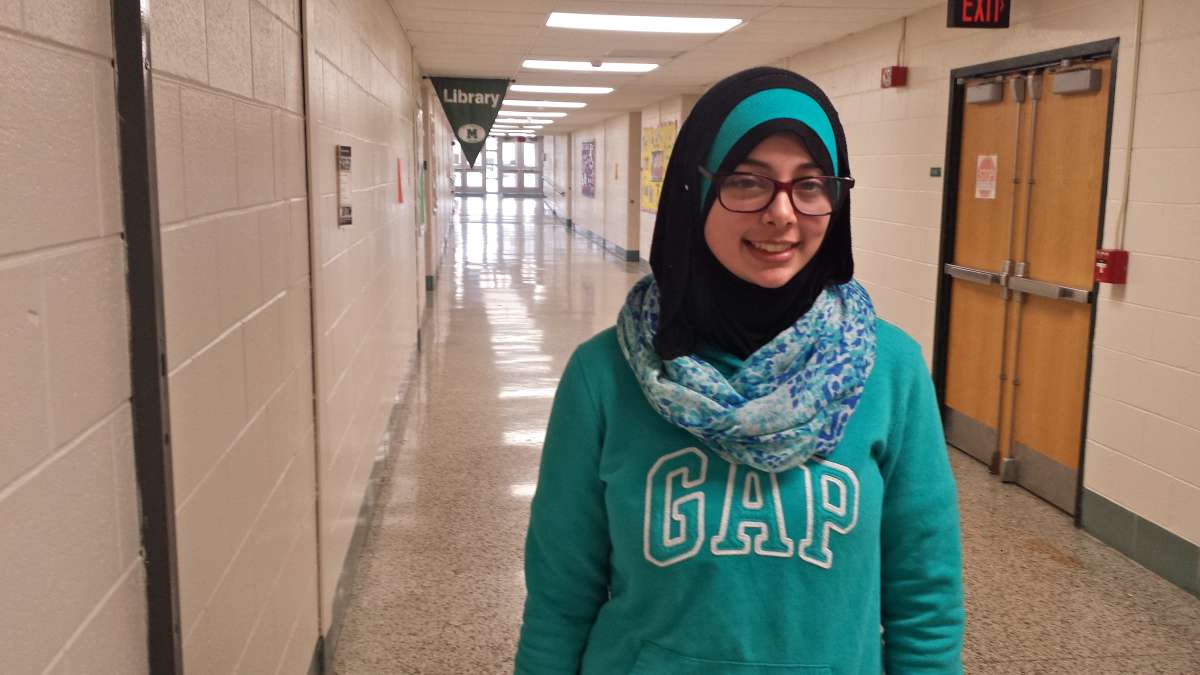
Kisha Manasrah, a senior at Kensington Heath Sciences Academy, was impressed by the facilites at Methacton High School. (Kevin McCorry/WHYY)
-
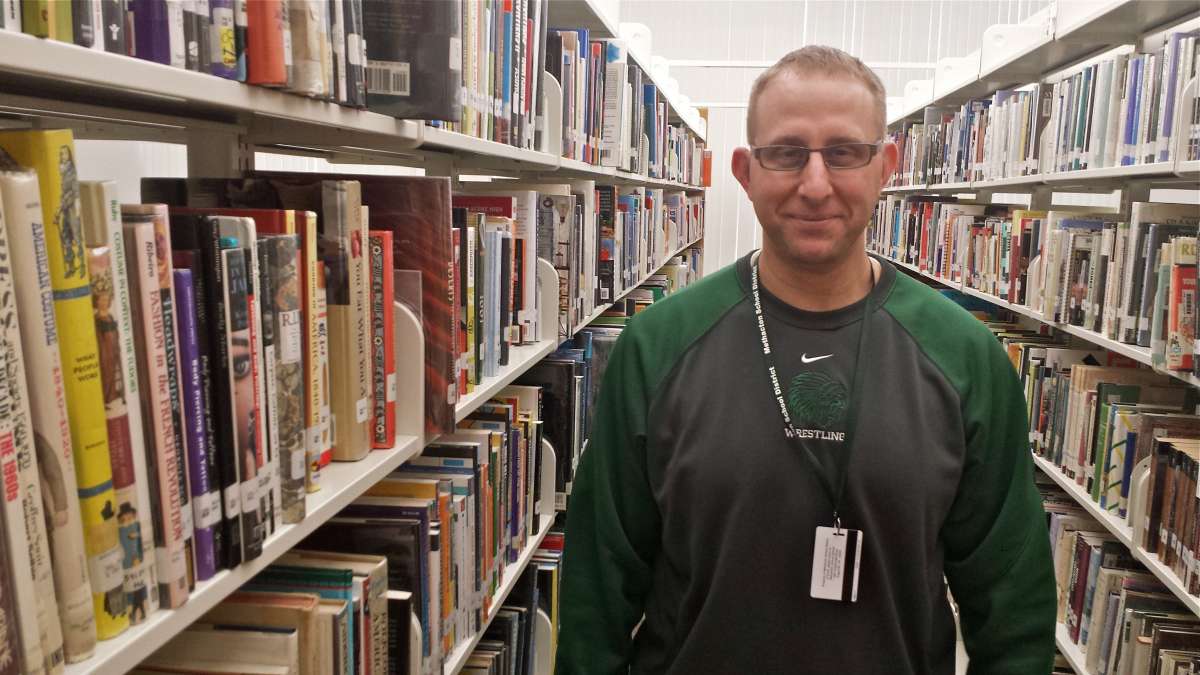
A. J. Maida, a social studies teacher at Methacton, organized the exchange between his high school and Kensington Health Sciences Academy. (Kevin McCorry/WHYY)
For one day, a group of Philadelphia teenagers experienced life at a wealthy, suburban high school. This is what they saw.
You can find the story of Pennsylvania’s education funding system carved into Hakeem Thompson’s biceps.
Thompson, a senior at Kensington Health Sciences Academy in Philadelphia, is a middle linebacker on the school football team. Because it can’t afford a regulation field, the squad practices on a crooked patch of grass behind a neighboring high school.
“Our field is not good at all,” Thompson says. “We play on rocks and everything.”
To prove it, Thompson lifts up his sleeves to reveal a scatter-plot of cuts and scars. When you play on ragged field, your body bears the testament.
Classmate Ruth Andujar scans the bruises stained across Thompson’s arms and offers a simple, excited evaluation:
“Yoooooo, that’s nasty.”
A bus ride to Methacton
When we first meet Thompson and Andujar, we’re barreling northwest on a school bus. This is technically a class trip, but our destination isn’t a museum or an amusement park. It’s another school.
We’re busing out to the suburbs, to see how the other half learns.
Our destination is Methacton High School in Montgomery County.
The Methacton School District is a paragon of privilege. The median income of district households is roughly $100,000. In the 2014-15 fiscal year, the district spent $19,471 per student on a school population that is almost entirely White and Asian. That’s the 71st highest spending total of the state’s 500 school districts. Just 15.7 percent of students are economically disadvantaged — compared to 50 percent statewide — and the 86 percent of graduating seniors who go on to college attend some of the world’s most prestigious universities.
The students from Kensington receive about $6,000 less per student per year from the School District of Philadelphia, which ranks 418th in per-student expenditures. They are almost entirely black and Latino and largely live in neighborhoods that rank among Philadelphia’s worst in terms of crime.
“You get people getting shot down, people getting caught up smoking weed every day,” says Andujar, who moved to Philadelphia from Puerto Rico about seven years ago. “You see that every day. You see prostitutes on every corner. It’s terrible.”
In some ways, Kensington fits the stereotype of a troubled urban school. Test scores are well below the district average and just two-thirds of its students graduate on time. The School District of Philadelphia announced late last year that it would implement turnaround plans at Kensington and 10 other schools because of consistently low academic performance.
But in other ways, Kensington surprises.
Far from dilapidated, its building is relatively new and cheery. It has a high-tech dental lab on site and will soon have its own pharmacy, thanks largely to outside organizations courted by James Williams, Kensington’s tireless principal.
When the district slated the school for intervention, the community fought back. Parents and staff argued that the school is one of Philly’s best. Over the last three years enrollment has grown from 432 to 469.
Still, there are differences — vast differences — between what a teenager receives at Methacton High School and Kensington. The very point of this trip is to highlight those differences, to show students in one of the Pennsylvania’s most cash-strapped school districts what it looks like to attend school in one of its richest enclaves.
‘How do they get their money?’
As the Kensington students arrive at Methacton they’re greeted by AJ Maida, a social studies teacher and the man behind this experiment. Earlier this school year, Maida decided to teach a unit on school funding.
This was partly out of passion — Maida gets “geeked out” on education policy stories, he says. But the former marine and the school’s wrestling coach also wanted the mostly privileged students in his honors classes to appreciate what they have and to understand the world beyond Methacton before they’re thrust into it.
Earlier in the year, five of Maida’s students visited Kensington. They also read “Savage Inequalities,” Jonathan Kozol’s 1991 book comparing the nation’s wealthiest and poorest school districts, and studied how housing discrimination informs school district demographics.
Throughout it all, they followed the money.
“So we started looking at how schools raise money,” Maida says. “Like how do they get their money?”
In Pennsylvania, as in many states, most of the money for schools comes from local property taxes. Naturally, wealthier districts can raise more. The money the state provides is supposed to help even this out. But it doesn’t work this way in Pennsylvania because the vast majority of dollars from Harrisburg aren’t doled out based on need.
The result is a funding system that some experts consider one of the least equitable in the country.
Today’s field trip is all about highlighting those differences.
“Take notice of what our facilities look like and what money does in education,” Maida says in his introductory remarks to the Kensington students. “That’s the goal for today, okay?”
Awe, excitement, and disappointment
After attending a class with Methacton students in the morning, the group of about a dozen Kensington students head to the cafeteria for lunch. On the way, they pass a wall of windows looking out over a turf football field Methacton installed over the summer — part of a multi-million dollar project that included an auxiliary field and two softball diamonds.
Hakeem Thompson beelines toward the glass, smiling and shaking his head.
“I went to a football camp out in West Chester, West Chester [University],” he says with a chuckle. “Their field can compare to West Chester.”
His classmate, Ibrahim Abdelghani, chimes in.
“For every sport they have a field,” he says. “We only have like one field for everything. So it’s kind of surprising how they get treated different from us.”
The rest of the day goes much like this. The Kensington kids see something bright and shiny — the arts wing, the gymnasium, the library. Or they’re told about all the things Methacton students have that they don’t — an academic help center, a school librarian, a dense catalog of courses that extends well beyond the subjects on standardized tests.
Some of the Kensington students, like Maritza Mancebo, react with awe and excitement.
“It’s like high school musical,” she says, beaming. “Everywhere you go it’s like something new.”
Other times the reactions drip with disappointment.
At one point, Maida leads the students to a deck overlooking the school’s pool. Down below, a class of Methacton kids splash about while the Kensington kids crack jokes that sound, at times, like laments.
Thompson notices a canoe bobbing in the chlorinated waters below.
“Forget the pool, we can’t afford the boat,” Thompson says to a chorus of laughter.
“It’s just obvious that they get a lot more funding than us,” says Viktorya Figueroa. “Waaaayyyy obvious.”
And how do they feel about the obvious disparities?
“I feel trashy,” says Andujar.
“I feel deprived,” echoes Figueroa, followed by another round of laughter.
A man on both sides of the divide
Shuffling alongside the group is Kensington’s Principal Williams, who can understand the divide between the two schools in a way few can. His daughter attends Methacton, a connection realized only after this trip had been arranged.
“I tell my daughter all the time, it’s daddy’s goal to create a school that she’s jealous of,” Williams says.
Williams admits that’s not possible right now with the way the funding system works. He concedes that the education his daughter receives at Methacton is better than the education at Kensington.
That’s frustrating and unfair, but Williams has decided he can’t just throw his hands up. So he’s gotten creative. He recruits idealistic young teachers from the University of Pennsylvania, and they now make up about one-third of his staff. To boost college readiness, he’s partnered with a local non-profit called 12+. Seemingly around every corner at Kensington, there’s evidence of some initiative Williams and his staff are launching.
“If I’m gonna sit around and wait for legislators to straighten this thing out, I’ll be grayer than I already am,” says Williams. “I mean, what else can we possibly do?”
David Trevaskis, a pro bono coordinator with the Pennsylvania Bar Association who helped arrange the trip, believes that eventually the government will have to iron out funding differences among school districts. For now, though, he hopes exchanges like this can move the conversation forward.
“I think one of the simplest ways to change it is by recognizing it and saying what the kids here were saying, that can’t be right,” he says.
The field trip ends back in the library where the students respond to prompts about what they’ve seen. Side-by-side, the Kensington and Methacton students mull questions that reverberate in the halls of Harrisburg.
- What makes a good school?
- If you could increase education funding, what would you spend it on?
- What role does funding play in the differences between Kensington and Methacton?
The conversations lurch forward — quick jokes followed by awkward silences. These are teenagers after all. And nothing unites teenagers like the universal desire to avoid embarrassment.
Finally, Maida asks the students why they think this trip has been arranged.
“So we could see we’re all the same,” says Ibrahim Abdelghani. “We’re the same, but we get treated differently.”
Headed home, bruises and all
On the bus ride home, the Kensington students digest what they’ve seen.
For some, the experience left a bitter taste.
“I’m pretty sure we’re all just as capable of learning as well as them, but we don’t have the resources or the opportunities to get as far as they are,” says Viktorya Figueroa.
Figueroa once attended a private school in one of Philadelphia’s wealthiest suburbs. She knows the difference money can make. Her family had to leave the suburbs after her mom stopped working to care for an elderly relative. Ever since, she’s been in Philadelphia public schools, never forgetting the education she left behind.
“I mean, it’s kind of frustrating when you think about all the resources and stuff that they have,” Figueroa says.
But when pressed on why this gap exists, most answers come with a shrug. That’s just the way it is. The suburbs are nicer than the city. The suburbs are cleaner, safer, more desirable.
“Nice neighborhood, nice school,” says Nathaly Irizzary. “Kensington — bad school, bad neighborhood.”
The twist here is that while the students assume most city schools are bad, they don’t feel that way about Kensington. And the mood heading home is disarmingly buoyant.
The Kensington students talk about all the things their school has that Methacton doesn’t. The student body at Kensington, they point out, is smaller. They feel a tighter relationship with their principal and with each other.
About 10 minutes before arrival, we find Hakeem Thompson, the middle linebacker, at the back of the bus. We ask him about that sparkling turf football field that looked like a college stadium. It was impressive, he admits. But it’s made him realize something about the field he has to play on.
“Our field is uneven and it has glass, it has rocks on it. It’s really dangerous playing on that field, but we get tougher from playing on it,” he says. “And like when you playing on a regular field — when we getting hit, it’s like nothing. It’s like we popping right back back up.”
Sometimes the playing fields are uneven — literally. But the story written on Hakeem Thompson’s arms isn’t just the story of inequality. It’s the story of the kids working to overcome it.
WHYY is your source for fact-based, in-depth journalism and information. As a nonprofit organization, we rely on financial support from readers like you. Please give today.




